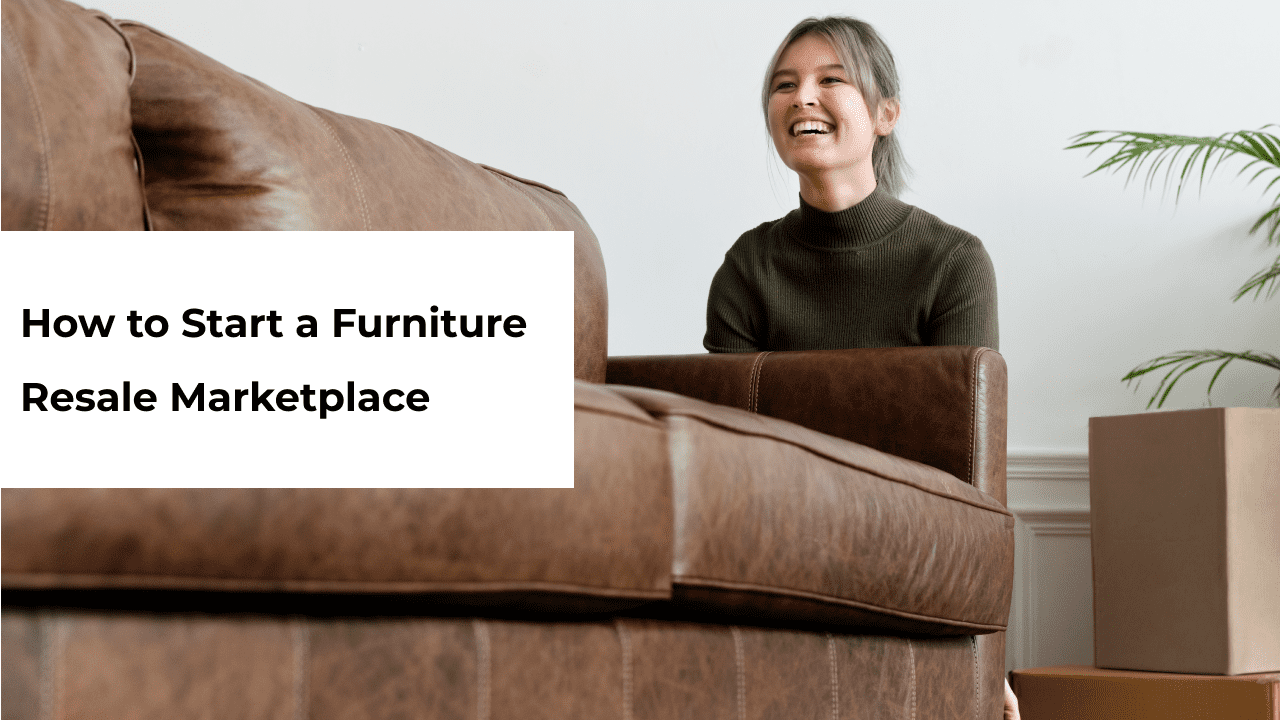Did you know the furniture industry dumps about 12 million tonnes of waste in landfills each year? Further, according to USEPA, the industry is the largest contributor to waste in the United States.
As the rising climate crisis creates more awareness, with changes undeniably visible in the biosphere, more consumers are considering sustainable alternatives by the day. Due to this, pre-owned furniture is gaining momentum with consumers as a more sustainable alternative.
Given the demand, the opportunity for Resale furniture marketplaces is ripe. Encashing in on this opportunity are marketplaces like Kaiyo. Interestingly, a figure of 5,424,019 has been highlighted on the Recommerce platform. This is the pounds of furniture the marketplace has kept out of landfills – indicating a rising consumer sentiment towards sustainable choices.

In this blog let’s read how you can start a furniture resale marketplace conveniently and affordably.
Table Of Contents
Business Sense in Starting an Online Furniture Resale Marketplace
Apart from eco-consciousness, multiple other factors are fueling the growth of the online furniture resale business. Let’s look at the benefits of a furniture resale marketplace for all platform participants.
Benefits for Customers:
1. Affordability: With furniture being a high investment, depreciating commodity, buying resale furniture is financially more viable.
2. Diverse Product Selection to Choose from: With multiple sellers, the chances of finding the more suited product are more.
3. User Reviews and Ratings: eCommerce platforms carry reviews and ratings of peers, helping consumers in their purchase decisions.
Benefits for Sellers:
1. Expanded Market Reach: A wide consumer audience.
2. Easier approach to add online sales: Brands considering online expansion of their operations, have an easier alternative with online marketplaces when compared to starting their own online stores.
3. Brand recognition: Online presence can fuel brand awareness for sellers, and give them exposure.
Benefits for Marketplace Operators
1. Asset light business: Marketplace owners don’t need to maintain inventory independently.
2. Increased User Engagement: Consumers can buy from multiple sellers.
3. Higher Revenue: More transaction volume means higher revenue from multiple channels.
4. Attracting D2C brands: D2C brands can give more value with fewer middlemen involved.
Launch a Platform Tailormade for all Participants
Start a Furniture Resale Marketplace
For starting an online furniture resale business, you will need to understand the industry, its growth drivers, challenges and possible solutions. You can consider adopting the following step-wise approach.
Choosing Operative Mechanisms of the Business
Before starting with building the marketplace, consider the popular ways in which the marketplace can be based. This will define the workflows, target audience, and the USP of the business.
Business Models
An online marketplace creates value by facilitating commerce between the sellers and the buyers on a broader level. However, this can be achieved in a number of ways depending on the market, products to be sold, sellers, and other factors. In the case of a furniture resale marketplace, the following operative business models are more popular.
1. B2B2C
The marketplace acts as an intermediary, digitizing the middlemen, and allowing third-party sellers to reach a customer base of the marketplace. The role of the marketplace operator is to provide the backend infrastructure and services such as shipping fulfillment, payment processing, and others. The sellers in such a setup can build their own brand.
In the furniture resale industry, a B2B2C business model will connect furniture resellers and D2C brands with the consumers on the platform.
2. P2P
A peer-to-peer marketplace like eBay simply connects peers to transact with each other. Buyers here can be sellers and vice versa.
3. Aggregator Marketplace
This business model combines the virtues of the B2B2C and the P2P business model. It connects sellers to the buyers, however, in this case, the marketplace business plays a more active role. The buyers here engage with the marketplace and not the sellers.
In some cases, like Kaiyo, the marketplace buys from the sellers and sells it to the buyers. This business model solves a key pain point in the resale industry. Sellers are typically people who simply want to get rid of their furniture and find an easy way to do it. Similarly, buyers get a reliable source, as the furniture has been verified by Kaiyo.
Cover Business Model Workflows Efficiently – With your Platform
Revenue Models
A marketplace typically provides multiple revenue-generation opportunities. Let’s consider the following:
1. Commissions: Marketplace businesses can charge commissions on every sale on the platform.
2. Advertisements: Website real estate assets like banner images can be monetized to display sellers’ adverts in lieu of a fee.
3. Subscriptions: Additional subscription services like booking a high-demand product, buy-back schemes, and others can be offered to increase the revenue of the platform business.
Essential platform functionalities – Navigate industry challenges
Like any other industry, the furniture industry comes with its challenges. However, these challenges can be met by including the platform with the necessary functionalities.
| CHALLENGE | SOLUTION |
| Shipping: Furniture shipping can be challenging. With greater weight and fragile components, the shipment has to be delivered with care. |
Automate with third-party API: The shipping can be outsourced to specialist logistics providers. The whole process can be automated by integrating their API with the platform. The automation will further facilitate accurate product shipment, correct invoices, and others. |
| Careful purchase decisions: Resale furniture can be more affordable than new, still, it is not an impulse buying decision for most consumers, especially in Western households. So the decision process can be lengthy. |
Detailed Product Descriptions: A rich-featured CMS within the platform will allow the addition of detailed product descriptions to assist the buyer to make the purchase decision. Inclusions like videos further can be helpful. Moreover, an engaging website UI further helps buyers to find what they are looking for and commit to the purchase. |
| No in-person feeling: Buyers can have additional queries regarding the style or feel of the product. Especially when it comes to the use of fabrics. |
Reviews with Parameters: Along with detailed product descriptions, user reviews can be helpful for buyers to gain trust and help them to commit to the purchase. If parameters are added to the reviews, allowing the buyers to rate the product based on the most critical parameters of the product. For instance, the feel of the fabric – the buyers will get additional information to arrive at the decision faster. |
Apart from these industry-specific pain points, other needs can be addressed by including the right set of features in the platform.
Create The eCommerce Platform
We discuss the process to build a furniture resale eCommerce platform below.
Market Research
The above-discussed variables give an insight into the preparation required in understanding the market dynamics. Moreover, these can vary with each market. So the success of your business depends on a thorough understanding of the market ― the existing competition, user needs, and other factors.
Moreover, if the business can solve user needs with the business, it stands a better chance of gaining user interest and eventually, a share in the market.
Build the Furniture Resale eCommerce Platform
There are two popular approaches available with you to build the eCommerce platform.
1. Custom made eCommerce platform: The marketplace platform will be built from scratch. This can be done either by hiring an in-house team or by outsourcing development to an eCommerce development company. Each aspect of the platform will be coded and further tested by the developers. This process can take time. Moreover, generally, companies will charge on an hourly basis, so this process can be resource-intensive as well.
2. Turnkey/Readymade solution: The alternative to the above-mentioned process is using a turnkey solution made for Furniture resale eCommerce marketplace.
How to choose which process suits you better?
If your envisioned eCommerce platform needs specific functionalities on multiple levels that are different from popular eCommerce platforms like Kaiyo, it may be better to opt for the former method.
On the contrary, leading furniture marketplace turnkey solutions are built with essential eCommerce features for the domain. Further, any customization needed can be done on the solution.
It might be difficult to decide on your own. It is better to discuss your plan with a company that offers both development approaches and find out the approach that suits you the best.
How Can Team Yo!Kart Help
Yo!Kart is a leading eCommerce marketplace platform that has powered more than 5000+ global e-marketplaces. It is self-hosted and customizable, giving entrepreneurs complete freedom to launch a platform to suit their business goals.
Yo!Kart has been built from the ground up to offer dedicated features for all platform participants. Likewise, Yo!Kart has holistic underpinnings to build a furniture resale marketplace. Furthermore, any specific customizations, for instance, an auction module, can be customized by availing in-house customization services.



